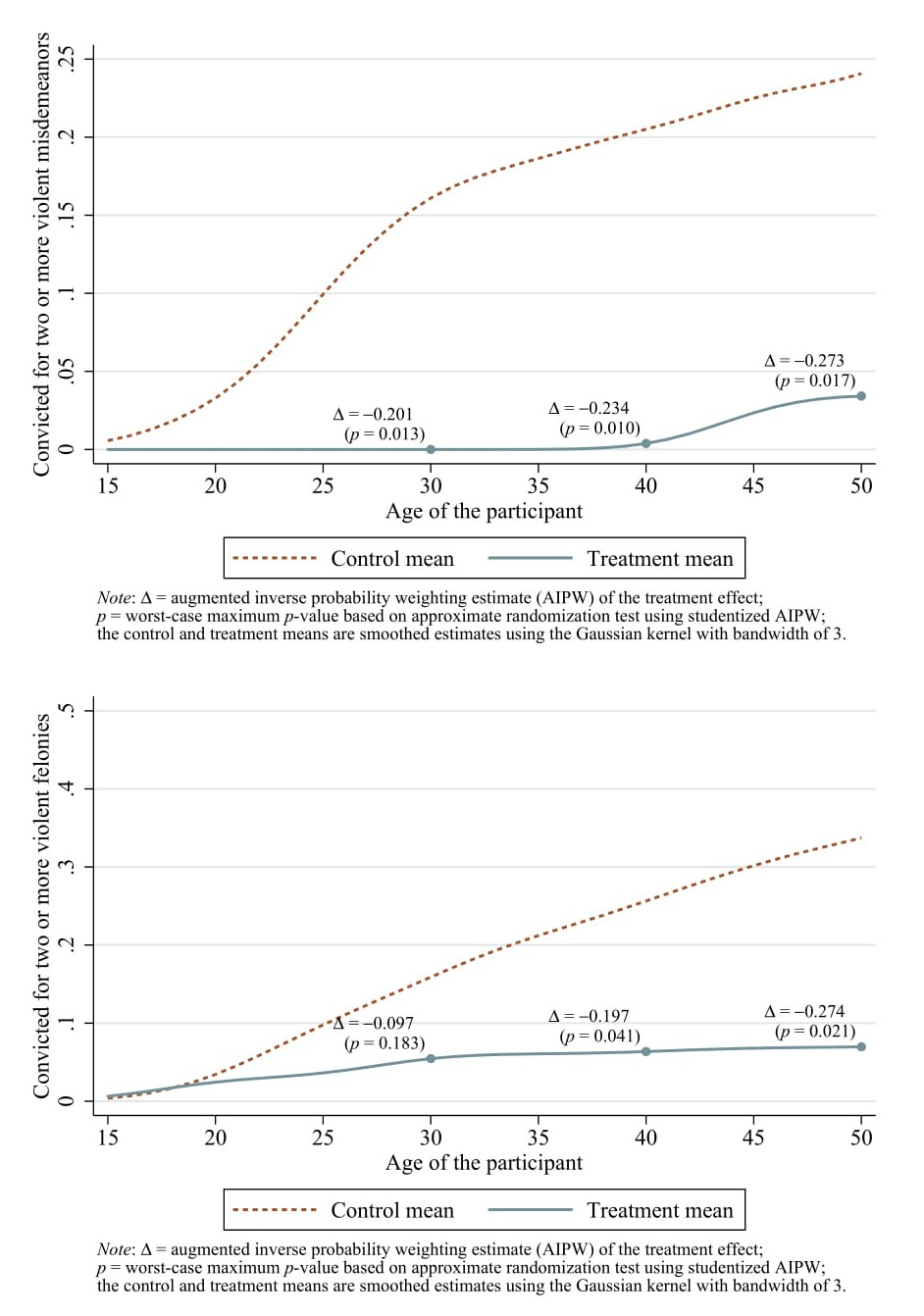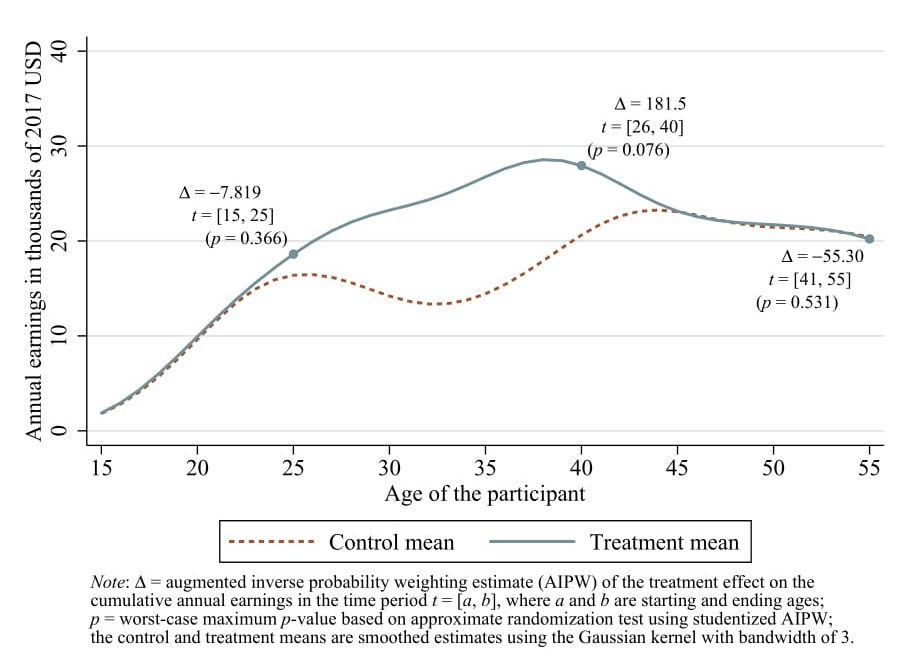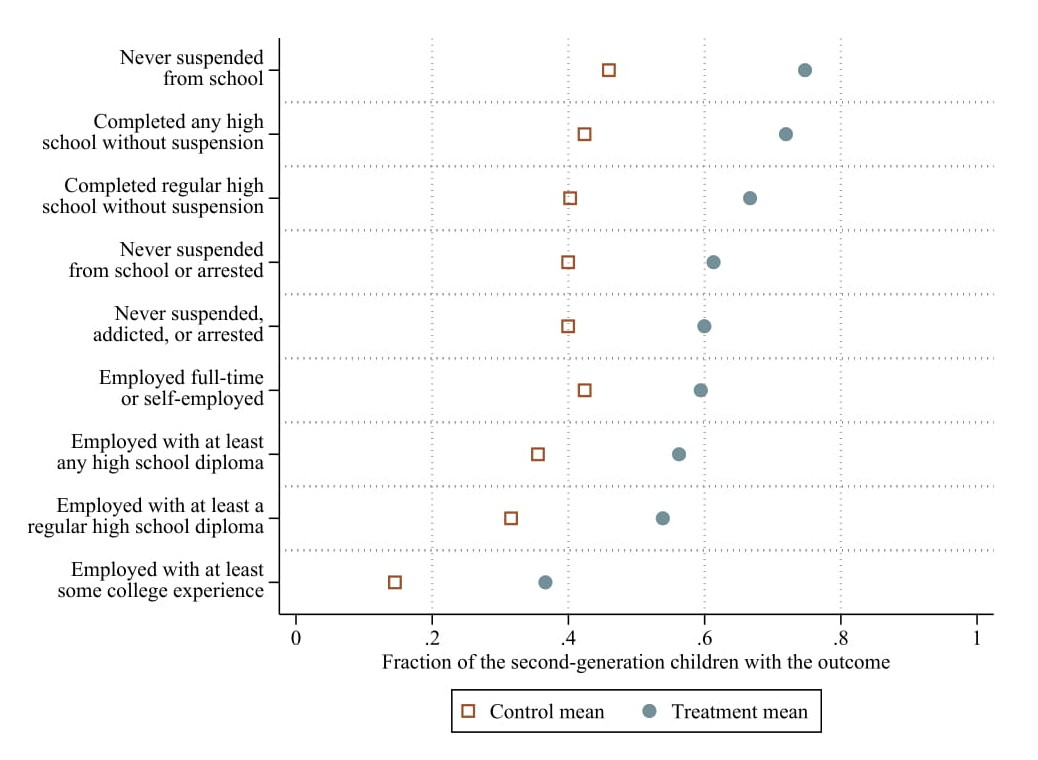An important challenge for public policy is to find ways to improve opportunity across generations. The Perry Preschool Project meets this challenge. It is the oldest early childhood experimental intervention with long-term follow-up. From 1962 through 1965, five cohorts of three- and four-year-old disadvantaged African American children from low-income families in Ypsilanti, Michigan, were enrolled in the experiment. The children were randomly assigned to a treatment group that received free preschool through age five. A control group, consisting of the remaining children, was not provided with the service. It was not contaminated because no alternative preschool options, such as Head Start, were available at that time in Ypsilanti. The intervention for the treatment group included 2.5 hours of centre-based active learning sessions on weekdays. The programme also included 1.5-hour weekly home visits by the Perry teachers to promote parental engagement with the child. An estimated 30% of Head Start centres use this curriculum (Walters 2015).
Participants are surveyed through late midlife. At the latest round of follow-ups, 80% of the original 128 participants, all of them around the age of 55, could be interviewed. Attrition is low and due primarily to death. Evidence on the original participants, their siblings, and the children of the original participants shows strong lifetime and generational impacts of the intervention. The original treated participants are less likely to engage in crime, and have higher earnings, more stable family lives, and better physical and mental health over their lifetimes. The lives of their siblings are also enhanced. Furthermore, programme benefits are conferred on the children of the original participants by having been reared in more stable and better resourced families.
Critics of the experiment point to many possible data defects that pose a challenge to rigorous analysis of the Perry data: a small sample size; compromises in and inadequate documentation of the randomisation procedure; and various forms of non-response, including attrition due to death. We address these challenges by constructing new conservative small-sample inferential procedures that explicitly account for the Perry experimental design (Heckman and Karapakula 2019a). We find, as feared, that standard testing procedures such as asymptotic, bootstrap, and permutation tests largely overstate the statistical significance of the Perry results. In response, we develop ‘worst-case’ p-values for randomisation-based causal inference. Our methods also apply to other compromised social experiments, including those using re-randomisation designs. Despite the statistically conservative nature of our hypothesis tests, we find that many statistically significant treatment effects remain after conducting a worst-case analysis.
Figure 1 Probability of two or more violent criminal convictions over time for males
Some of the strongest effects of the programme are on the criminal activity of the original male participants. For example, administrative criminal records show that 23% of the control group men have two or more criminal convictions for violent misdemeanours by age 50, whereas only 3% of men in the treatment group have such convictions. The respective percentages for violent felonies are 33% and 7%. These effects also translate into relatively higher employment and earnings for the treated men, especially in early middle age. Using new biomarkers measured through epidemiological exams, we also find that the treated men and women have better health than the control group at the most recent follow-up survey. We explore plausible mechanisms producing these treatment effects: long-lasting improvements in executive functioning and socioemotional skills; and increases in the quality of childhood home environments and parental attachment.
Figure 2 Mean annual earnings over the life course for males
The original participants are old enough to have adult children. The children of the treated participants have lower school suspension and arrest rates and higher levels of educational attainment and employment relative to their control counterparts (Heckman and Karapakula 2019b). We account for the non-random nature of the second-generation samples, made up of the offspring of the original participants, using a variety of methods. Our core results are robust to the method used. These comparisons are facilitated by the fact that the overall fertility patterns of the original treated and untreated participants are similar.
The second-generation children in the treated families are 30 percentage points less likely to be suspended from school than those in the untreated families. This is policy-relevant because African American students are disproportionately suspended from public schools across the US. We also find substantial effects – 20 percentage points or higher – on the second-generation children in terms of never having been suspended or arrested, being employed, being employed with at least a high school diploma, and being employed with at least some college experience.
Figure 3 Statistically significant intergenerational effects at the 10% worst-case level
There are important gender differences in the intergenerational programme benefits. The male children of the treated male participants are substantially less likely to be arrested and more likely to graduate from college and to be employed with some college experience or a college degree, compared with those in the control families. The female children of the treated male participants are less likely to be suspended from school and more likely to complete high school and to be employed, relative to their counterparts in the control group. Additionally, male children of female participants experience beneficial treatment effects in terms of school suspensions, college attendance, and employment. We do not find any statistically significant effects on the female children of female participants. Most of the intergenerational impact of the Perry programme seems to be concentrated on the children of the original male participants.
To explore the mechanisms producing these spillover effects, we examine the family lives and neighbourhood choices of the original Perry participants. Recent studies using population-level data emphasize the role of neighbourhoods per se in shaping child outcomes (Chetty et al. 2018, Chetty and Hendren 2018a,b). A large body of social science research shows the importance of family structure and resources in moulding children (Almond et al. 2018, Currie and Almond 2011, Heckman 2008). While our data do not enable us to reach precise conclusions, we find suggestive evidence that families matter much more than neighbourhoods in explaining the observed impacts.
Stable two-parent childhood home environments are three times more common for the second-generation children in treated families compared with those in control families. For male children of the original male participants, such environments are fifteen times more common relative to their control counterparts. In addition, the children of the participants, especially those of the male participants, also experience positive treatment effects on childhood income resources in terms of parental earnings. However, the neighbourhoods of the original treated participants when their children were living at home are no better than those of the control participants. In fact, the neighbourhoods of the treated women are worse along some dimensions, such as the number of two-parent families, median household and family income, and poverty among families with children. We do not find statistically significant differences by treatment status in the neighbourhood choices of the original male participants. Our study offers suggestive evidence that any adverse neighbourhood effects were more than reversed by improvements in childhood home environments for the second-generation children because of the Perry intervention.
In addition to these intergenerational effects, we also find beneficial intragenerational spillover effects on the participants’ siblings who were present at baseline but not eligible to participate directly in the programme. Such siblings, especially the males, experienced significant positive treatment effects on high school graduation and employment.
The body of evidence from our work shows that high-quality preschool interventions targeted at disadvantaged children have the potential to strengthen families and reduce poverty and inequality across multiple generations. Our research also demonstrates the value of long-term follow-ups of early intervention programmes.
References
Almond, D, J Currie, and V Duque (2018), “Childhood circumstances and adult outcomes: Act II”, Journal of Economic Literature 56(4): 1360–1446.
Chetty, R, J N Friedman, N Hendren, M R Jones, and S R Porter (2018), “The opportunity atlas: Mapping the childhood roots of social mobility”, NBER Working Paper 25147.
Chetty, R and N Hendren (2018a), “The impacts of neighborhoods on intergenerational mobility I: Childhood exposure effects”, The Quarterly Journal of Economics 133(3): 1107–1162.
Chetty, R and N Hendren (2018b), “The impacts of neighborhoods on intergenerational mobility II: County-level estimates”, The Quarterly Journal of Economics 133(3): 1163–1228.
Currie, J and D Almond (2011), “Human capital development before age five”, Elsevier, Handbook of Labor Economics, Volume 4: 1315–1486.
Heckman, J J (2008), “Schools, skills, and synapses”, Economic Inquiry 46(3): 289–324.
Heckman, J J and G Karapakula (2019a), “The Perry Preschoolers at late midlife: A study in design-specific inference”, NBER Working Paper 25888.
Heckman, J J and G Karapakula (2019b), “Intergenerational and intragenerational externalities of the Perry Preschool Program”, NBER Working Paper 25889.
Walters, C R (2015), “Inputs in the production of early childhood human capital: Evidence from Head Start”, American Economic Journal: Applied Economics 7(4): 76–102.






